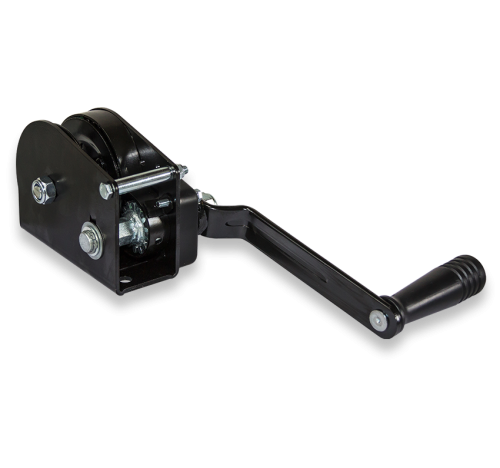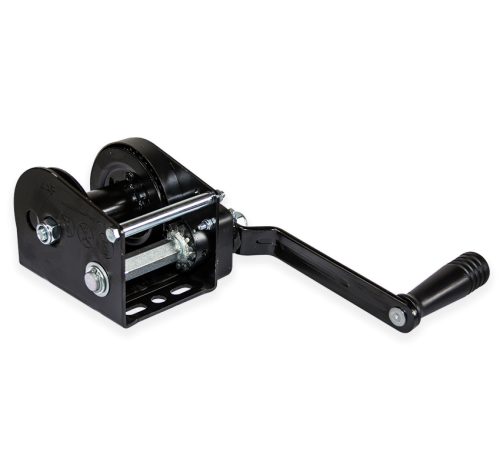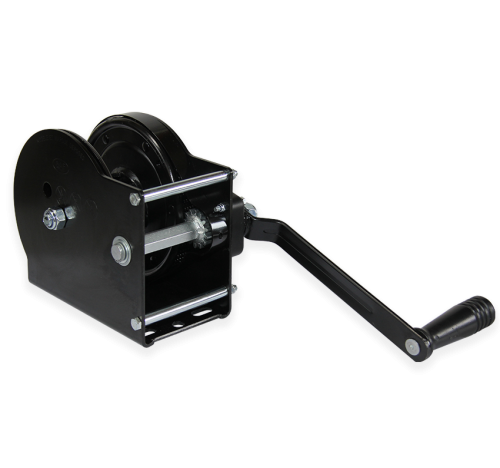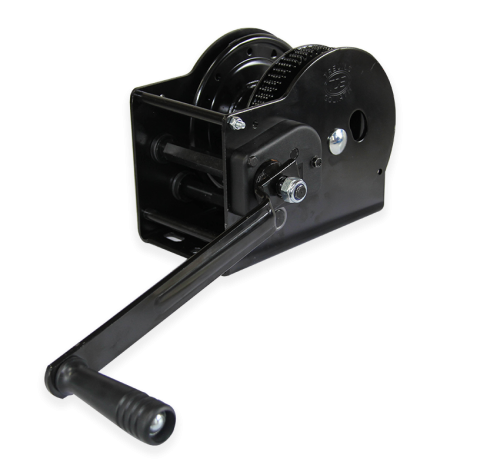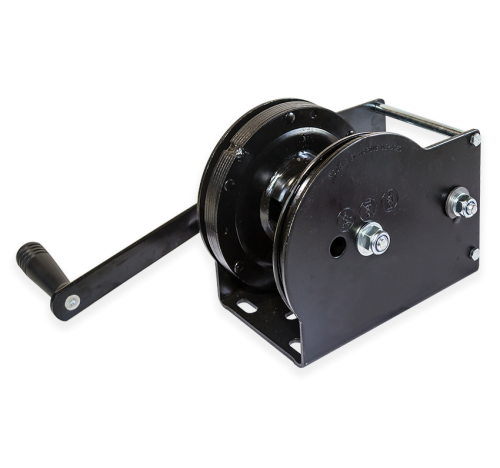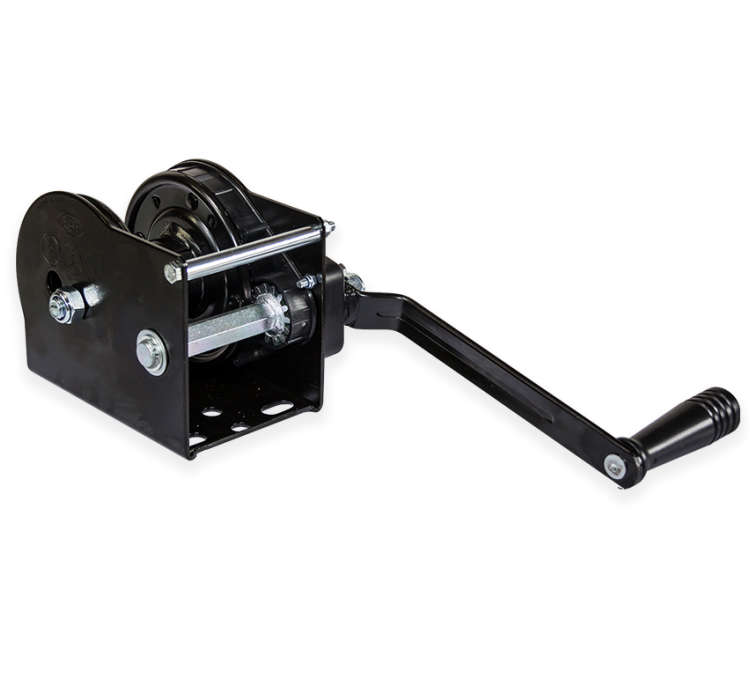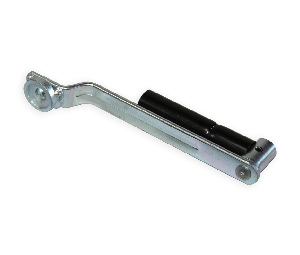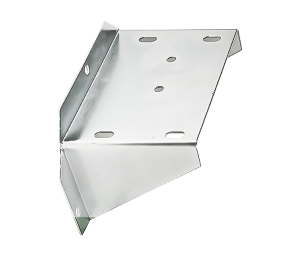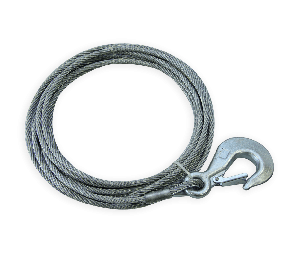Language
Winch 6AFD black
Ref.:
PF55609-C1
€121.27
incl. vat
In stock
Goliath brake winch for towerlifts (entertainment industry).
- Load held without any action on the handle.
- First layer capacity 500kg
- Last layer capacity 240kg
- Black cataphoresis coating/high anti-corrosion protection
More Details
- Load held without any action on the handle.
- First layer capacity 500kg
- Last layer capacity 240kg
- Black cataphoresis coating/high anti-corrosion protection
-

3.69
-
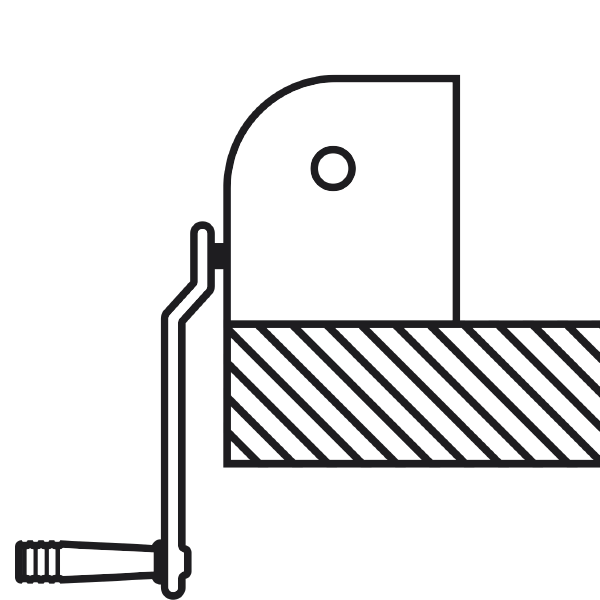
Standard mount
-
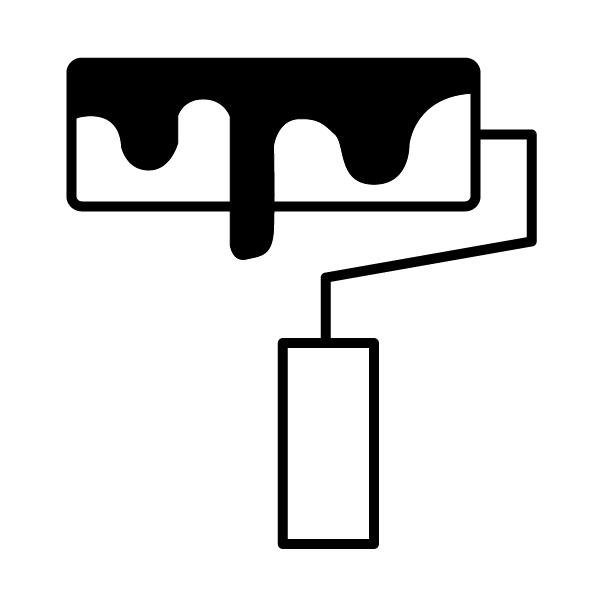
Black zinc coating
-
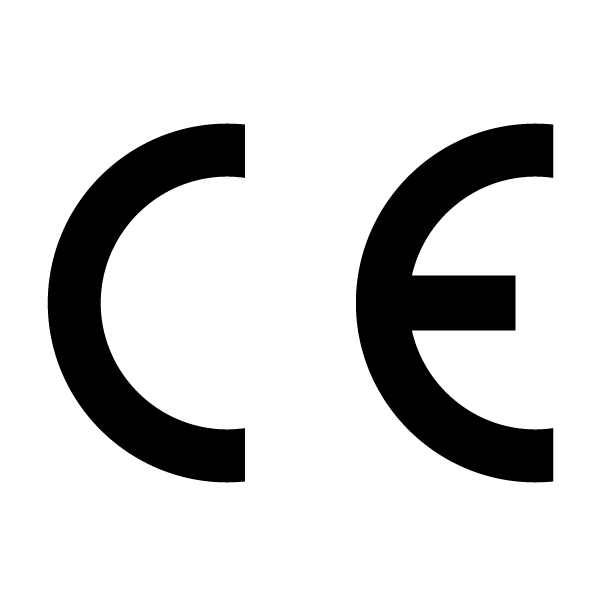
European standard EN13157-A1
-
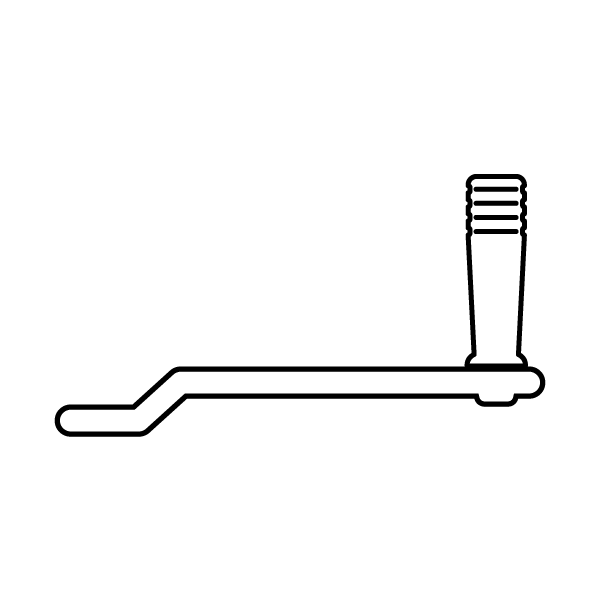
Fixed handle
GOLIATH has been designing and making, for more than 30 years, winches that are used in a great number of industries.
The manual winch is a safety device governed by strict technical rules and whose design is framed by the European standard EN13157 A1.
Here are some criteria to be taken into account to select the right winch.
Lifting concept
Always select a brake winch.
According to the European standard EN13151 A1, a lifting application is characterised by the lifting of a load in connection with a vertical and/or horizontal movement. Thus, towing a car on a trailer, for example, is a lifting operation.
The winch associated with this operation must be compliant with the standard EN13157 A1 to be EC marked. It must in particular have a permanent safety brake when loaded (as the range of ratchet winches does not have a self-braking system, it is therefore not suitable for lifting applications). This device is crucial to ensure your safety and the compliance of your facilities.
The winch safety brake makes it possible to hold the load when all action on the handle is stopped. The latest generation of GOLIATH safety brakes (internal, permanent and independent from the handle) of the TPV,TA and TS winches offer constant safety, including when the handle is removed (prevents unauthorised access to the winch).
Pulling on an inclined plane: Pulling on an inclined plane is a lifting operation
Whether the load is self-supported or not, the force, and so the winch capacity, can significantly vary (from 1 to 5 depending on the case). The load capacity we provide in our datasheets for this type of application takes into consideration a slope of 20% and friction coefficients corresponding to those of a vehicle equipped with bearings.
Force on the handle: 12 kg maximum recommended
Quality winches designed in compliance with the European standard EN13157 A1, are provided for a maximum load capacity with a force on the handle that cannot exceed 25 kg first layer and last layer load).
This is a rated capacity and not a capacity of use. In general, one considers that a 12 kg force on the handle is acceptable. To obtain this maximum force level, the load on the winch should be limited to approximately 50% of its rated value.
Please note that the latest generation of TPV-TA winches are equipped with 2 reduction axes making it possible, according to uses, to divide the force on the handle by 2. See the new generation of TA-TPV winches
Capacity: The wound cable length has an impact on the winch capacity
The load capacity of the winch (100% force applied directly to the cable) depends on the cable winding level on the drum. In fact, the mechanical force transmited by the cable to the winch proportionally increases with the winding of the latter on the drum. In other words, the more the load is lifted, the more the transmitted force is significant, thereby reducing the capacity of the winch. For this reason, the standard considers a first layer and a last layer load:
- 1st layer (drum pitch diameter diagram)
The first layer is the minimum filling level of the drum. The load capacity of the winch given for a 25 kg force on the handle is then maximum, but is not a use value, as the winch cannot be used with this load (lifting/winding capacity equal to 0).
- Last layer (full drum diagram)
The maximum last layer load value, still for a 25 kg force on the handle, is the maximum capacity of the winch if the cable is completely wound on the drum.
Consequently, the winch capacity will depend on the cable length wound on the winch when the load is lifted to the maximum. To optimise this value and select the winch best suited for the application, it is necessary to limit the cable length wound on the drum to strictly: lifting height + 1 metre (minimum safety winding on the drum). Our Goliath Store configurator allows you to carry out simulations and indicates the references best suited for your application.
Cables: Adhere to the recommended diameters
Each winch is determined according to a cable diameter adapted to its capacity. It is then recommended for optimum use of the winch to use the corresponding cable. A cable with a close diameter can eventually be used. WARNING! In this case, the winch capacity will eventually be reduced proportionally to the difference in breaking capacity of the cable.
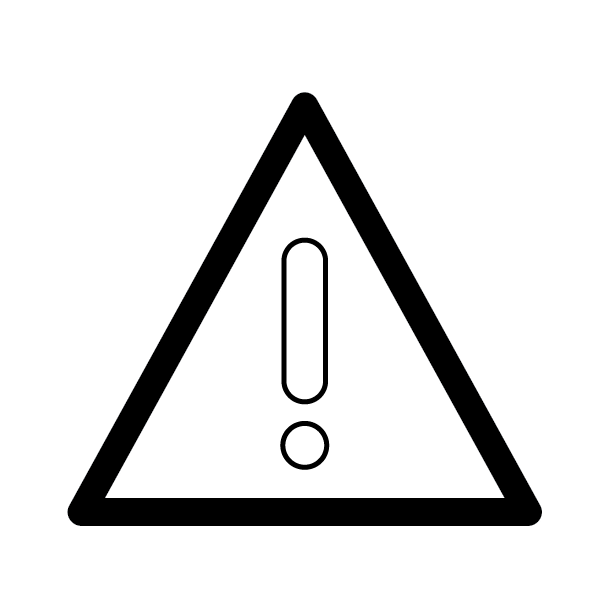

Protective cover: Compulsory to be compliant with the EC standard and for your safety
It is imperative that the winch be equipped with a protective cover preventing access to the mechanism in order to avoid any accident.
- Unit weight : 3.69 Kg
- Number of speeds : 1
- Reduction ratio 1 : 1/3.5
- Drum hub ø : 45mm
- Brake : auto frenante
- Last layer use value (kg) : 240
- Theoretical value first layer (kg) : 500
- Rolling load capacity slope 20% (kg) : 750
- Cable 1 Ø (mm) / length (m) : ø5/12m
- Cable 2 Ø (mm) / length (m) : ø4/22m
- Winch weight : 3.6kg
- Number of winches per masterpack (pro) : 1
- Handle length (mm) : 200mm
- Handle : Fixed
Since the 1980s, GOLIATH has gradually become the leading European manufacturer of manual winches. Our products, known for their quality, are distributed in all industries and integrated in numerous lifting products.
Our sustained investments in R&D for more than 10 years allowed us to launch new products every year. The Goliath range has thus become the most complete and competitive offer in terms of manual winch on the market, whether it concerns standard winches or lifting solutions dedicated to an application.
AN EXTENSIVE OEM APPLICATION EXPERIENCE
Our industrial flexibility, associated with a significant component library, allow us to offer, at low cost and within a limited time, lifting solutions suitable for the needs of integrators.
Our technical expertise in a great number of industries and applications allows us to easily adapt to OEM needs, with an industrial customisation approach.
Technical tailor-made solutions for industrial volumes (from 100 pieces a year, and for more significant systems up to several thousand units).
Winch solutions
We provide integrators with customised solutions by adapting our winches (handle lengths, accessories, mounting system, additional handles, etc.) or by creating tailor-made products (reduction, size from our standard or modified component libraries according to specifications).
Telescopic solutions and hoist arms
Our telescopic masts are available in standard or customised version up to 6 metres and 300 kg-load according to requirements. Our solutions also integrate accessories and mounting systems.
We also make hoist arm and davit systems in steel, aluminium, or stainless steel intended for handling various equipment.
Lifting system solutions
Talbot Industrie provides overall lifting solutions intended to equip vehicles or industrial handling systems.
MOBILE SOLUTIONS
Talbot Industrie is also a manufacturer of trailers and offers tailor-made combined mobile lifting solutions, including lighting management solutions, material handling, building equipment and installation assistanc
The EN13157 A1 standard defines the essential criteria required to ensure your safety and justify the CE mark on winches (in the context of European use).
Warning ! Affixing the CE mark may be linked to self-certification by the importer or manufacturer, which unfortunately leads to misuse of its use and therefore of CE conformity of the products. Be careful.
A winch that does not comply with EN13157 A1 is not CE, thus making the lifting device not in compliance with the provisions of the Machinery Safety Directive that engages your responsibility.
Below you will find some essential requirements for the CE qualification of a winch. Of course, the qualification cannot be summarized in such few lines. Our objective here is to allow a visual identification of the key elements of conformity :
- Automatic brake: Self-braking is mandatory for any lifting application. As a reminder, standard EN13157 A1 defines lifting as a change of height during movement. This can integrate all combinations of vertical and/or horizontal movements of the load.
- Crank: It must not be disassembled when the activation of the braking system depends on it.
- Safety cover: The inner and outer components and the protruding parts of the system (e.g. the drum) must be protected.
- Drum: The diameter of the hub of the drum varies according to the cable and measures, depending on the case, between 35 mm and 72 mm (for manual winches up to 1000 kg). Failing this, the fiber of the cable can be damaged and can lead to the breakage of the cable. In addition, the hub of the drum must resist crushing.
- Securing the cable or the strap: The anchorage of the cable or strap on the winch must be standardized and withstand 3 times the nominal load.
- Straps and cables: They must comply with current European and safety standards and or must be testproof. Be careful with weak straps! When damaged, their breakage could have serious consequences.
La norme EN13157 A1 définit les critères essentiels requis pour assurer votre sécurité et permettre l’application du sigle CE sur les treuils (dans le cadre d’un usage Européen).
Attention ! L’apposition du sigle CE peut-être liée à une auto-certification de l’importateur ou du fabricant, ce qui conduit malheureusement à un usage abusif de son utilisation et donc de la conformité CE des produits. Soyez vigilant.
Un treuil non conforme à la norme EN13157 A1 n'est pas CE, rendant ainsi le dispositif de levage non conforme aux dispositions de la directive sur la sécurité des machines qui engage votre responsabilité.
Vous trouverez ci-dessous quelques critères indispensables requis pour la qualification CE d’un treuil. Bien entendu, la qualification d’un treuil ne saurait se résumer à ces quelques éléments. Notre objectif est ici de permettre l’identification visuelle des éléments clès de conformité à la norme :
- Auto frein de sécurité: L'auto-frein est obligatoire pour toute application de levage : Pour rappel, la norme EN13157 A1 définit le levage comme un changement de hauteur pendant le mouvement. Cela peut intégrer des mouvements verticaux ou verticaux et horizontaux de la charge ainsi que toutes les combinaisons.
- Manivelle : Ne doit pas être démontable lorsque l’auto-frein en dépend.
- Carter de protection : Les pignons internes et externes ainsi que les éléments saillants du système (par exemple le tambour) doivent être protégés.
- Tambour : Le diamètre du moyeu du tambour varie en fonction du câble et mesure, suivant les cas, entre 35mm et 72mm (pour les treuils manuels jusque 1000 kg).
A défaut la fibre du cable peut être endomagée et peut conduire à la rupture de celui-ci. De plus, le moyeu du tambour doit résister à l’écrasement. - Sécurisation du câble ou de la sangle : L’ancrage du câble ou de la sangle sur le treuil doit être normalisée et résister à 3 fois la charge nominale.
- Sangles et câbles : Ils doivent être conformes à la normalisation européenne en vigueur. Attention aux sangles trop fragiles! Endomagées, leur rupture aura des conséquences parfois dramatiques.
Need A Custom Solution?
With 40+ years of manufacturing innovation, we're ready to develop products to your exact specifications. Let's create the perfect solution for you.
Request a quotation


